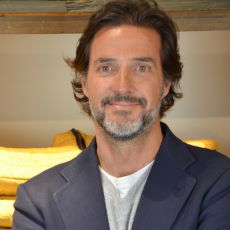Javier, tell us about the beginnings and development of Ecoalf – what spurred the idea and what is your current global footprint?
The idea to create a sustainable fashion company came to me at the end of 2009. I had been working in the fashion industry before and I realized that the most sustainable thing to do was to stop using natural resources in a careless way, seeing recycling as a solution. When I went to the market in 2009, there were no recycled fabrics, or just a very small percentage. So, we had to start developing our own fabrics and up to this point have created 642. We now use around 90% recycled fabrics and the other 10% are what we call low impact. We end up using fabrics that are substitutes of cotton, but which use 70% less water, such as hemp.

Nevertheless, being sustainable goes beyond the fabric. In fashion, the business model itself is unsustainable. It is all a cycle of buying and throwing, buying and throwing, which means that countless numbers of garments end up in landfills every year.
I read recently about the biggest cotton company in the world burning 4000 acres of forest yearly. We are burning forests to plant cotton to make cheap t-shirts that will end in landfills in less than two years. We are going to be 10 billion people on earth by 2050: there are not going to be enough forest, nor landfills. Plus, each of those t-shirts requires about 1.500 liters of water, so there is not going to be enough water either. In other words, we must absolutely change the business model as a whole. We have stores in Madrid, Barcelona, Berlin, Paris, Milan and Tokyo, and are opening one in Los Angeles soon.
Do you think that introducing more long-lasting materials would be an appropriate solution?
Yes, definitely. We have to invest much more in durability than in quantity. Unfortunately, one of the biggest problems right now is that people often opt for quantity over quality. Some fabrics are considered sustainable when in fact they are not. For instance, a fabric that is made of 50% polyester and 50% cotton can never be recycled, despite common belief.
Do you suggest that there must be a necessary tradeoff between affordability and sustainability in fashion?
Creating sustainably makes the process more complicated and more expensive. This is the case for any industry at present, however I believe that it should be the other way around. As an illustration, we use laces for our sneakers made from recycled PET bottles. When we go to manufacturers and we buy, say, 10,000 laces, the price is naturally very high. But if the whole industry would do the same, then these laces would be far more affordable. If we want this process to go quicker, which is a necessity, and for it to be more affordable, we need the big brands, the ones that have the volume and resources, to take it seriously. Change cannot come about from pockets of sustainable collections, while 95% products remain wasteful.
Are you pleased with the results of the Ecoalf Foundation thus far?
Indeed, since 2015 we have come a long way with the foundation. We had been recycling fishing nets for many years. At one point I was talking to a fisherman at the harbor, and he invited me to go fishing with him to see how much waste went into his net, which was shocking to witness. People do not realize, but marine debris, from a plastic cup to an aluminum foil can sinks down to the bottom of our oceans. From thereon we decided to start a project called ‘Upcycling the Oceans’ and we convinced three fishermen from a little harbor in Alicante to let us put a container to collect all that waste. Presently, we work with 5.000 fishermen, in 78 harbors, including Spain, France, Greece, and Italy; and we have the goal to work with 10,000 fishermen by 2025 and collect 1.000 tons of waste from the bottom of the ocean every year. Importantly, 68% of this waste we then put back into the system.
Have bigger brands started to emulate your model, paying attention to what you do, partnering with you?
I think so, yes. We are in contact with very big companies, and it is good to see how devoted they are to making tough decisions, and not simply for the sake of appearances. Ecoalf is a small company, but if we are able to take 1.450 tonnes from the ocean floor, big companies could take much more. If we can save billions of liters of water every season with our recycling model, big companies could be saving much more. If we can make 78% of our collection monofilament, they could do the same. So, it is possible.
Are you optimistic about the future of the planet, given how far we have to go still?
Absolutely. It is important to bear in mind that the planet has a huge capacity to recover. I see it in what we do with the ocean floor: 95% of the marine forestation comes back in just a short period once you remove the waste. We must decide what kind of planet we want by 2050 and act on it - this applies to everyone, citizens, consumers, brands, and legislators.






